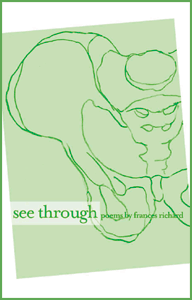
paper • 87 pages • 14.95 ISBN-10: 1-884800-48-3
DICTIONARY EPISODE
I looked you up in the shallow water dictionary. It said
black and blue, said
awkward scar, forget-me-not
noli me tangere
kind of thing.
Foam slaps the oar-locks. Spume drowns. A stained safety
orange, salt-stiffened gloves for example, or starting
the car with a screwdriver fixed in ignition. That can be yours; I’ll
use episode, as
when the girl enters the fête in her novel, in muslin, her premodern
shift. Match-head flame in the orchid, core roseate
with big voltage. Urge—further it. We feel shy,
as if breathless were cozy. Now this alcohol
sting of the mind, I can’t read, as on marshland the windows
are oozing, not solid but slow-moving
gel. Did you know glass is permanent liquid? So stand here
a temblor, see outer: quilts, pots, dust, excitement. And inner:
snow. It
depends. Parts bulbed and fructified, furred
bow in rattling orchestra.
A soughing thing fattened
and bullied by boring wind. Want that, want laugh and
tough match-head
burns in the orchard, stripped edges. Soothe, you flare.
“Frances Richard’s poems know how to end. It’s hard to trust a poet who doesn’t get ‘there’ — or know she has. Frances is keenly aware that that is the job. In short, we’re managing death. Her path intrigues me too: layered, brainy, wise-guy. She is definitely a poet to watch — she is writing between schools, even in spite of them…She courts the sexy anonymous. She writes quietly and fiercely with the unpleasant force of nature yowling behind her back. These are elegant and sculpted poems that manage to scare me. Where is she now?” —Eileen Myles
“I am transported by Frances Richard’s poems, their permanent liquidity, their ‘breathing surface.’ Throughout the cycle that makes up the book, a narrative trace of a mother’s suicide weaves the watery texture of experience. These stunning poems show us that in the face of loss, it is things that breathe. Fragments of memory move through the details of objects to haunt language. Then the haunting is our carriage, taking us beyond narrative even as it shatters. See Through is an exquisite achievement.” — Claudia Rankine